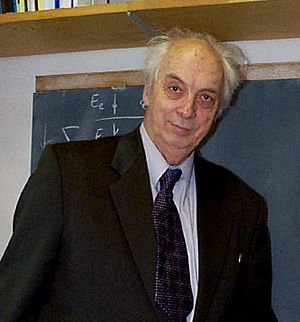Victor Veselago facts for kids
Quick facts for kids
Victor Georgievich Veselago
|
|
|---|---|

Veselago c. 2006
|
|
| Born | June 13, 1929 |
| Died | September 15, 2018 (aged 89) |
| Alma mater | Moscow Institute of Physics and Technology |
| Known for | Metamaterials |
| Scientific career | |
| Fields | Physics |
| Institutions | Moscow Institute of Physics and Technology |
Victor Georgievich Veselago (born June 13, 1929, in Ukraine – died September 15, 2018) was a brilliant Soviet and Russian physicist. He was a university professor and held a high degree in physical and mathematical sciences. In 1967, he was the first to share an important idea: what if materials could have negative values for two key properties, called permittivity (ε) and permeability (μ)?
His most famous work was a paper titled "The Electrodynamics of Substances with Simultaneously Negative Values of ε and μ." It was first published in Russian in 1967 and then translated into English in 1968. This paper was super important for new discoveries in electrodynamics and optics. Many other scientists have used his ideas in their own research.
Throughout his life, Victor Veselago received awards and kept contributing to the field of electrodynamics.
Contents
Early Life and Physics Journey
When Victor Veselago was in high school, he loved ham radio. This hobby got him really interested in how electricity works, and that led him to study physics. He went to Moscow State University, where a new physics department had just opened. He spent four happy years there learning about science.
A professor named Mark Yefremovich Zhabotinsky helped Veselago with his final project. This professor also taught him a lot about radio electronics and electrodynamics. Veselago also learned from Professor Semen Emmanuilovich Khaikin and Professor Sergei Mikhailovich Rytov. These teachers really helped shape his scientific path.
The biggest moment in his career was when he realized that materials could actually have both negative permittivity and negative permeability. This idea changed how scientists thought about light and materials.
His Big Idea: Negative Materials
Victor Veselago's first big paper was about "The Electrodynamics of Substances with Simultaneously Negative Values of ε and μ." Before his work, scientists always thought that the refractive index of a material (which describes how light bends when it passes through something) could only be a positive number.
But Veselago showed that the refractive index could also be negative! He guessed that this could happen if a material had both negative permittivity (how a material reacts to an electric field) and negative magnetic permeability (how it reacts to a magnetic field).
His amazing prediction came true 33 years later! In 2000, a scientist named David Smith and his team created a special material with a negative refractive index. These special materials are now called metamaterials.
Veselago also predicted that a flat piece of these negative materials could act like a special curved lens. Sir John Pendry later showed this in his lab. He found that this "Veselago lens" could make images much clearer.
After Smith and Pendry proved his ideas, Veselago realized something even bigger. His paper wasn't just about making materials with negative refraction. It was about being able to design materials to have *any* value for permittivity and permeability. This means scientists can now create materials with properties never seen before! He also believed that many old physics formulas needed to be updated to include these new negative values.
Veselago thought the next big step for metamaterials would be to create clear, low-absorption versions that could bend light negatively in the visible spectrum (the light we can see).
Education and Career Highlights
Victor Veselago graduated from Moscow State University in 1952. He earned his PhD in 1959 for studying how molecules create light (molecular spectra) using a method called radiospectroscopy. Later, in 1974, he received a higher degree, a Doctor of Science, for his work on solid materials in magnetic fields. He earned both of these advanced degrees while working at the Lebedev Physical Institute.
After graduating in 1952, he started working at the Lebedev Physical Institute in Moscow. He stayed there until 1983. In 1983, he became the Head of the Laboratory of Magnetic Materials at the same institute.
In 1980, he also became a professor of applied physics at the Moscow Institute of Physics and Technology. He was very interested in magnetism, solid-state physics, and electrodynamics.
Besides his famous work on negative refraction, Victor Veselago received many honors. He won the State Prize for science of the USSR in 1976. He also received the academician V.A. Fock prize in 2004 and was named an Honored Scientist of the Russian Federation in 2002. In 2009, he won the C.E.K. Mees Medal from the Optical Society of America (OSA). This award is given to scientists who show that "optics transcends all boundaries." In 2011, Professor Victor G. Veselago was even nominated for a Nobel Prize!
He was also on the advisory board of the scientific journal Metamaterials, which started in 2007.
Victor Veselago was married and had three daughters and one son. His favorite animal was his female cat, Fifa. He had a unique hobby: he loved real railways, not just model trains!
See also
- Metamaterials
- Negative index metamaterials
- Photonic crystal
- 2009 recipient of the OSA
- Kenneth Mees Medal

